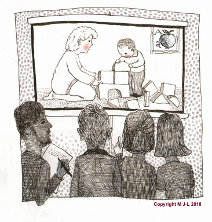Out with the old (medical) and in with the new (educational) for babies and infants who have a multifaceted condition

‘How can we deliver our necessary expertise to help a baby or young child’s development and learning without all piling in separately?’
Does the cartoon excite you? It excites me because I love the idea of a small team observing a child closely and coming to a shared decision about how to help. This is multidisciplinary action (and perhaps multiagency too) and, by working at a distance when possible, avoids overloading child and parents.
Some babies and young children have a combination of conditions that affect how they will develop and learn. Very often, these stem from neurological impairment that can affect, in some combination, the child’s vision, hearing, communication, cognition, behaviour, posture, socialising, movement, etc.
In out-dated early support systems, still very current in the UK and other countries, there is a long-held belief that these multiple conditions in development and learning must be addressed by multiple professionals working directly and separately with the child. Too often the professionals work as a loose ‘group’ and do not gel into a collaborative ‘team’.
This is much more a medical approach than an educational one and it does the child and family no favours. Very often, it adds to their problems by endangering attachment, giving young children a very unnatural life, and causing exhaustion and stress to infants and parents. Nothing is done in this approach to support a quality of life for infant or family.
Stuck stubbornly in this 20th century medical/institutional approach, there is rarely any collective effort in which professionals get together to consider:
‘How can we deliver our necessary expertise to help a baby or young child’s development and learning without all piling in separately?’
‘How can we respond to an infant’s global functioning with a global intervention system?’
‘How can we be interconnected in our interventions to anticipate and facilitate the interconnections in the infant’s natural activities?
These would all be obvious and important questions if we weren’t hopelessly stuck in the old medical idea that children function in separate compartments – that each facet of a baby or young child’s multifaceted condition can be treated in isolation. When we watch a toddler playing alongside others, we realise that everything comes into play and that such separate professional compartments as movement, perception and communication exist only in the minds of medicalised professionals.
TAC philosophy, principles and practice are built on whole-child interconnectedness. Each TAC meeting is the perfect multidisciplinary forum for intelligent collective action – key professionals and parents together. Here, plans can be agreed for reducing the number of professionals working directly with the child and parent. TAC members can explore how to get all necessary expertise integrated into the child and family’s natural activity. An element of this will be for some professionals for a period of time to work at a distance.
These ideas are explored:
In Early Childhood Intervention without Tears
Cartoon from TAC Bulletin Issue 218:

I would welcome news from teams in any country who have found ways to work at a distance.
Peter Limbrick, April 2018

